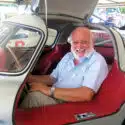Looking ahead to the 100th anniversary of the RAC Grand Prix
Done with F1-75? So is Doug Nye who is already keenly anticipating a celebration at Brooklands next year

Malcolm Campbell gives chase in his Bugatti in a battle royal at the 1926 RAC GP, Brooklands
Getty Images
Whisper it. We are just passing the centenary of the so familiar Brooklands silencer, largely a product of post-WW1 middle-class incomers complaining about the noise from Weybridge’s Brooklands Motor Course. Silencer regulations launched in 1924 failed to appease them and in 1925 a High Court action saw a blanket requirement introduced.
But meantime there was more to British motor racing through the 1920s. Several of its new-era racing celebs gained genuine international prominence. Henry Segrave, Malcolm Campbell and J.G. Parry Thomas all took the Land Speed Record. In road racing Segrave’s Sunbeam won not only the 1923 French Grand Prix, but also the major San Sebastián race the following year. In response the FIA’s forerunner – the AIACR – offered the British Royal Automobile Club the honour of a Grand Prix of its own for ’25. They finally accepted for 1926 when the first GP race on British soil really did take place – complete with ‘Brooklands box’ silencers attached.
Next summer the Brooklands Museum is organising a celebratory event honouring the centenary of that very first RAC Grand Prix. Never mind 75 years of Formula 1, this will be a more profound landmark history, reminding us not only that there was Grand Prix racing before Formula 1, but also that there was a World Championship series as well, if only through 1925-26…and the GP Formula regulation change which that entailed.
Economically, the mid-20s were hardly roaring. Post-World War 1 instability saw an American stock market dip and declining commodity prices. Britain faced chaos due to a general strike while commitment to the gold standard hampered exports. In France meanwhile public debt had gone through the roof, accompanied by political meltdown and a new government enforcing low interest rates and thereby causing widespread labour unrest – this might sound weirdly familiar?
Against this background, in 1926 the governing AIACR ran its second annual World Championship for Grand Prix Constructors, while simultaneously launching new 1½-litre supercharged rules for competing cars, down from 2 litres. Few manufacturers readied their new cars in time.
The ’26 French GP at the flat and featureless Miramas track near Marseille saw only three starters, Bugattis, of which only one completed the full distance. The latest Delage 1.5LS straight-eights were fast, but with their engine exhaust manifolds wrapped close over the right-side seated driver’s footbox, pedal and cockpit temperatures would prove near unbearable.
The following European GP – a full seven-hour borefest on the immensely challenging San Sebastián road circuit at Lasarte – doubled the number of starters…to six. Then followed our first RAC Grand Prix race at Brooklands with – glory be – no fewer than 13 entries.
“In the second surviving Delage at Brooklands, Sénéchal’s shoes ignited”
It was to be run on a new ‘road-type’ version of the Brooklands track, specially modified with two sandbank ess bends introduced on the Finishing Straight to entertain the expected crowds. In preparation several alternatives had been tried, with garish yellow builder’s sand trucked in for the purpose. A bridge was built across the track while the chicanes were tested assiduously by Segrave’s 1923 French GP riding mechanic, Paul Dutoit, in an elderly Alvis. The bridge had two piers sited actually on the circuit, racers having to pass beneath its right-hand span after braking desperately hard for the entry chicane, slither for the crowd’s delight on the inevitable grit, then accelerate into and out of the second ‘ess-bend’, up onto the home banking, then left-handed away around the high-speed Outer Circuit, and back – after a 2.6-mile lap – to tackle the sand again.
Sunbeam was part of the Sunbeam-Talbot-Darracq group, bearing the now unfashionable initials STD. It entered three of its lowline straight-eight Talbots. Delage promised three of its hot-stuff straight-eights, Parry Thomas was completing two ‘flat-iron’ Thomas Specials, Alvis entered a startling front-drive straight-eight while George Eyston was to run an Aston Martin and Major Frank Halford his six-cylinder special with his own engine in an Aston frame. Campbell was listed in an old four-cylinder Talbot before buying a new Bugatti Type 39A.
Non-starters whittled the starting field to nine. The untested Talbots proved a handling disaster with front axles a frenzied blur under heavy braking. Jules Moriceau’s collapsed its front suspension on lap one entering the first chicane. Eight runners left, 109 laps remaining. Louis Wagner’s Delage failed, his feet already burned. Seven left. Segrave led before Robert Benoist’s Delage drew away. Eyston retired. Six left. Near half-distance Benoist’s Delage exhaust split, not helped by Brooklands-silencer back pressure.
Segrave retired. Five left. In the second surviving Delage, Robert Sénéchal’s shoes ignited. Wagner took over Sénéchal’s car. Halford retired. Four left. Albert Divo’s fast Talbot retired. Three left. Lounge-suited André Dubonnet took over Benoist’s singed car, learning the circuit. Campbell’s Bugatti passed him for second place. And Sénéchal/Wagner won by 9min from Campbell, earning the £1000 first prize, more like £78,000 today.
Through pain they raced 100 years ago next summer. Watch out for 100 running GP cars (of all ages) at ‘The Track’ next year.

